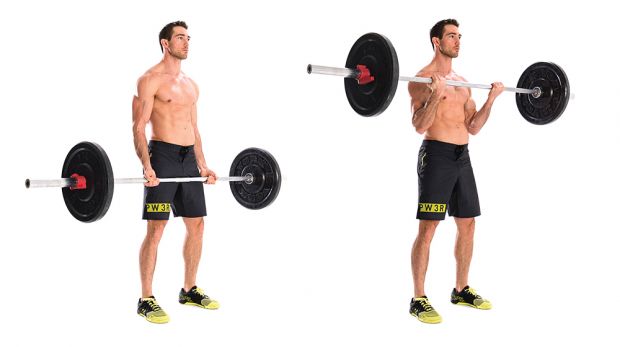The barbell curl is a time-tested and proven way to build up your biceps. Some trainees often find themselves overdoing the barbell curl and the bench press, but that does not take away from the effectiveness of the exercise. There are many ways to use this exercise so let’s take a look and you’ll see why it is a staple in so many routines.
Muscles Targeted:
The barbell curl primarily targets your bicep and your forearm muscles. These are the only muscles involved in actively lifting the weight. Several other muscle groups play a role in stabilizing the weight while lifting but are not prime movers. If you use an overhand grip instead of the usual underhand, you will target the muscles on top of your forearms.
Exercise Instructions:
Using a shoulder width grip, grasp a barbell with an underhand grip. Stand up straight with your feet about shoulder width apart. Curl the bar up toward your chest in an arc, keeping your elbows locked in the same place close to your sides. Bring the weight up as high as you can and squeeze the biceps at the peak of the movement for a one-count. Lower the weight slowly, and return to the start position and repeat.
Why This Exercise is Important:
Barbell curls are many trainees’ first step towards beginning weight lifting. The reason for that it’s simple since it’s fun and easy to do. Plus your biceps are right there for everyone to see and who doesn’t want the so-called “beach muscles” to stand out and look good. Seeing someone with toned or even muscular arms serves notice to everyone that the individual takes care of their body. There are other functional reasons why someone will want to devote time to the barbell curl. The biceps accounts for 1/3 of upper arm mass and needs to be developed to balance out the triceps. Focusing too much on bench pressing can lead to imbalances that the barbell curl can help alleviate. All rowing and pulling motions require strong biceps to move heavy weight. Using the reverse grip can help strengthen your forearm and grip strength.
Things To Avoid:
While barbell curls are seemingly simple to the novice lifter, the experienced gym goer knows that there is a great deal to work on for the perfect curl technique. Here are some things to avoid. When lifting the bar resist the tendency to jerk the weight up. This can take the stress off the biceps and onto other muscle groups. Avoid leaning back too far to lift the weight up. This is a sign the weight is too heavy. On the other hand avoid leaning over too far to get the weight up as well. This is also a sign of the weight being too heavy. Make sure you avoid shortened range of motions and go all the way up and down. Avoid any grip style that is giving you pain. Try different grip widths and maybe reduce the weight.
Reps and Sets:
You’ll want to go fairly light on the barbell curl in order to keep the stress on the biceps. However, some lifters advocate going heavy even if the weight is partially lifted by other groups. Keep your sets between 2-4 and repetitions in the 6-12 range.

